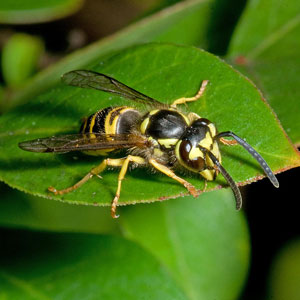The Late Summer Yellowjacket Blues!
By Chris Williams on July 25, 2013.

Question
Why are yellowjackets always such a pain at this time of the summer? I usually don’t notice them at all until sometime in late July. Then it seems like they’re everywhere and literally in your face!
Answer
It’s hard to believe we’re into mid-summer already. There are two main reasons why we are noticing yellowjackets now: (1) Yellowjacket colonies continue to grow in number of workers during the summer. We simply are less likely to notice them when colonies are small with fewer workers. (2) Yellowjackets’ diets change in late summer as a result of colony decline, and they become more aggressive in their foraging for food.
Yellowjackets are social insects which means they live in a colony with a queen and workers. Yellowjacket colonies start out in the spring with a single fertilized queen who has survived the winter. She begins the nest and personally rears the first group of workers, feeding the larvae and caring for them. Once these larvae turn into worker wasps, they take over the duties in the colony and the queen’s job is then to lay eggs to make more workers for the colony.
Yellowjacket nests are almost fully developed now and will soon be at their maximum size (about 4,000 workers). In late summer, next year’s queens are developing in the nest but larval development is ending—no new workers are being produced. In the fall, the workers and the queen die, leaving new queens to spend the winter alone. Unfortunately, as the summer goes on, yellowjackets also tend to become more aggressive as the social structure of the colony breaks down.
In late summer, yellowjacket workers no longer have to worry about collecting insects to feed developing larvae in the nest. Since they are randomly foraging just for themselves, their tastes change from protein foods to sweets. That’s why they become more interested in our soda cans, what we’re having at our picnic, and the hummingbird feeder. This change of diet brings them into closer contact with people and they aggressively go after food, sometimes with negative results.
You won’t have to put up with yellowjackets too much longer. In our region, yellowjacket colonies begin to decline in July or August, but some remain active through September. If you’re having a real problem with yellowjackets around your home, give us a call. We can locate and treat yellowjacket nests so that you can enjoy the rest of your summer in peace.
Photo credit: e_monk / Foter / CC BY-NC-SA